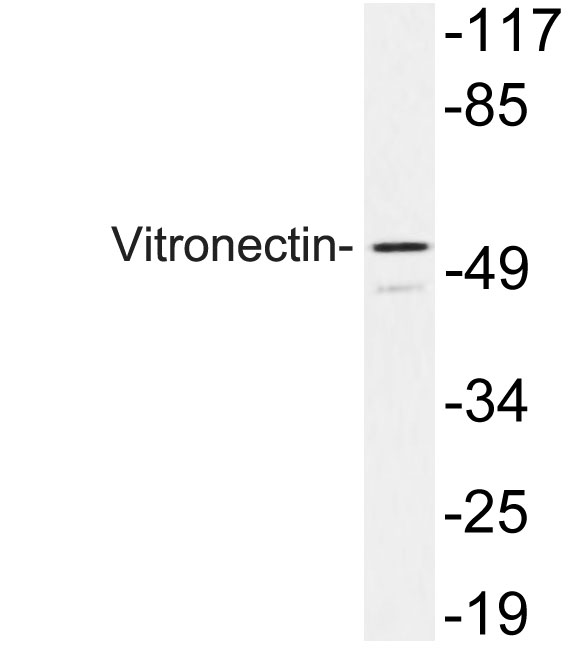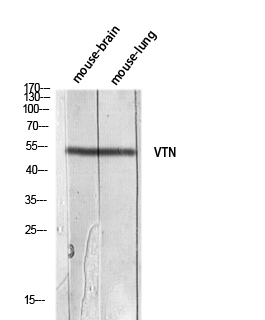Vitronectin Polyclonal Antibody
- Catalog No.:YT4884
- Applications:WB;ELISA
- Reactivity:Human;Mouse;Rat
- Target:
- Vitronectin
- Fields:
- >>PI3K-Akt signaling pathway;>>Focal adhesion;>>ECM-receptor interaction;>>Complement and coagulation cascades;>>Human papillomavirus infection;>>Proteoglycans in cancer
- Gene Name:
- VTN
- Protein Name:
- Vitronectin
- Human Gene Id:
- 7448
- Human Swiss Prot No:
- P04004
- Mouse Gene Id:
- 22370
- Mouse Swiss Prot No:
- P29788
- Immunogen:
- The antiserum was produced against synthesized peptide derived from human Vitronectin. AA range:209-258
- Specificity:
- Vitronectin Polyclonal Antibody detects endogenous levels of Vitronectin protein.
- Formulation:
- Liquid in PBS containing 50% glycerol, 0.5% BSA and 0.02% sodium azide.
- Source:
- Polyclonal, Rabbit,IgG
- Dilution:
- WB 1:500 - 1:2000. ELISA: 1:10000. Not yet tested in other applications.
- Purification:
- The antibody was affinity-purified from rabbit antiserum by affinity-chromatography using epitope-specific immunogen.
- Concentration:
- 1 mg/ml
- Storage Stability:
- -15°C to -25°C/1 year(Do not lower than -25°C)
- Other Name:
- VTN;Vitronectin;VN;S-protein;Serum-spreading factor;V75
- Observed Band(KD):
- 55kD
- Background:
- The protein encoded by this gene is a member of the pexin family. It is found in serum and tissues and promotes cell adhesion and spreading, inhibits the membrane-damaging effect of the terminal cytolytic complement pathway, and binds to several serpin serine protease inhibitors. It is a secreted protein and exists in either a single chain form or a clipped, two chain form held together by a disulfide bond. [provided by RefSeq, Jul 2008],
- Function:
- domain:The SMB domain mediates interaction with SERPINE1/PAI1. The heparin-binding domain mediates interaction with insulin.,function:Somatomedin-B is a growth hormone-dependent serum factor with protease-inhibiting activity.,function:Vitronectin is a cell adhesion and spreading factor found in serum and tissues. Vitronectin interact with glycosaminoglycans and proteoglycans. Is recognized by certain members of the integrin family and serves as a cell-to-substrate adhesion molecule. Inhibitor of the membrane-damaging effect of the terminal cytolytic complement pathway.,PTM:It has been suggested that the active SMB domain may be permitted considerable disulfide bond heterogeneity or variability, thus two alternate disulfide patterns based on 3D structures are described with 1 disulfide bond conserved in both.,PTM:N- and O-glycosylated.,PTM:Phosphorylation on Thr-69 and Thr-76 favors cell
- Subcellular Location:
- Secreted, extracellular space .; Parasitophorous vacuole . (Microbial infection) In P.falciparum-infected red blood cells, VTN internalization is detected at the early trophozoite stage (PubMed:29567995). Colocalizes with SERA5 at the schizont stage and with SERA5 P47 at the merozoite surface (PubMed:29567995). .
- Expression:
- Expressed in the retina pigment epithelium (at protein level) (PubMed:25136834). Expressed in plasma (at protein level) (PubMed:2448300). Expressed in serum (at protein level) (PubMed:29567995).
- June 19-2018
- WESTERN IMMUNOBLOTTING PROTOCOL
- June 19-2018
- IMMUNOHISTOCHEMISTRY-PARAFFIN PROTOCOL
- June 19-2018
- IMMUNOFLUORESCENCE PROTOCOL
- September 08-2020
- FLOW-CYTOMEYRT-PROTOCOL
- May 20-2022
- Cell-Based ELISA│解您多样本WB检测之困扰
- July 13-2018
- CELL-BASED-ELISA-PROTOCOL-FOR-ACETYL-PROTEIN
- July 13-2018
- CELL-BASED-ELISA-PROTOCOL-FOR-PHOSPHO-PROTEIN
- July 13-2018
- Antibody-FAQs
- Products Images

- Western blot analysis of lysate from 293 cells, using Vitronectin antibody.


